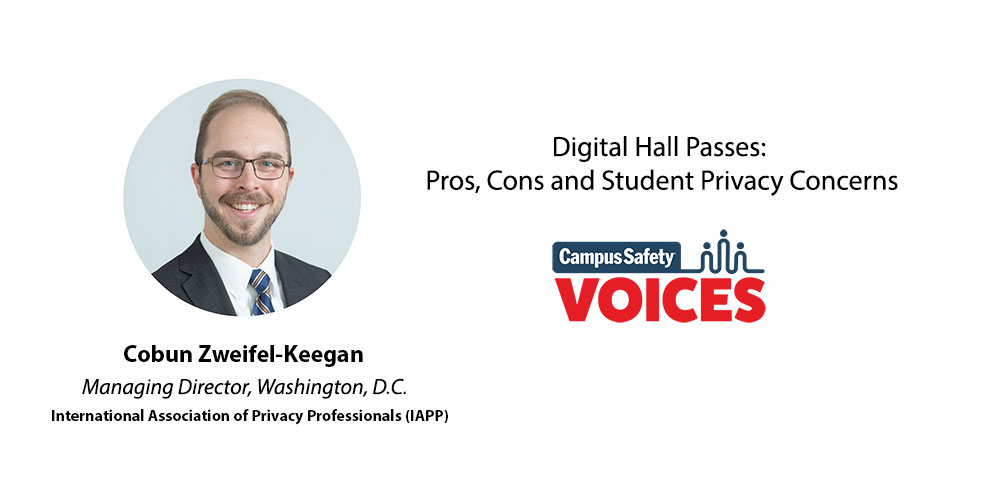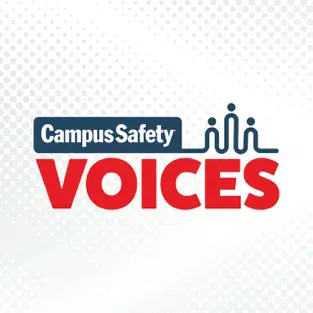Most Campus Safety readers are likely from a generation where they wrote their name on a sign-out sheet if they had to leave the classroom. Like with most everything, technology now exists to streamline this process.
Often touted as a way to curb vandalism and vaping while improving overall student safety, digital hall passes are now used by thousands of schools across the country. Like with any technology, schools must weigh the pros and cons of these systems before implementing them. To help compare the benefits of the technology with some of the risks and potential harm to students, we spoke with Cobun Zweifel-Keegan, a data privacy lawyer and managing director of the International Association of Privacy Professionals (IAPP).
“Schools and providers are really focused on efficiency, and in looking at [digital hall pass] solutions, schools are often persuaded by this argument that a uniform digital dashboard is simpler for teachers and for students to use than a paper-based system,” Zweifel-Keegan said about one of the technology’s benefits (3:08). “In theory, it means not interrupting class as much because rather than having to interrupt the teacher to get a piece of paper signed, the teacher can seamlessly use their iPad and authorize the transaction during the course of their teaching.”
Aside from ease of use for both educators and students, there are proven safety benefits.
“There’s more security, more accountability in a system like this,” said Zweifel-Keegan. “Something that schools point to is that with paper records, you don’t necessarily have a central system so it may be difficult to track in a school where students aren’t in a single room all day. It would be difficult to track how many times students are ‘abusing the privilege’ of being able to go out of the classroom. And then, of course, it’d be harder to identify when vandalism and things like that happen. It takes more legwork from the administrators than if it’s already inside a centralized dashboard.”
Student privacy is a main concern voiced around any technology that collects personally identifiable information as some companies may analyze the collected data in addition to administrators (5:38). Zweifel-Keegan says the most important thing to consider when choosing a digital hall pass vendor is whether the platform commits to using collected data only for the purpose of serving the school or improving the product. If a vendor can’t make that commitment, it’s a red flag.
“Schools need to make sure they’re talking to vendors, that they’re really focused on exactly which types of information are going to be collected by the vendor, how that’s going to be used, what the clear limits are on the purposes for which that data is collected,” he continued. “Making sure that the vendor isn’t planning to disclose that information to others to sell it and that it’s going to be basically under the control of the school but exercised through the vendor.”
To minimize exposure, Zweifel-Keegan says regulators are pushing for data minimization, meaning data controllers would limit the collection of personal information to what is directly relevant and necessary to accomplish a specified purpose.
“If you’re thinking of the minimum viable product here for a hall pass, they might need to know the student’s name and their student I.D. number,” he said. “Beyond that, make sure you’re checking up and asking questions like, ‘Does this additional piece of information actually add value to the service?’ That’s an important thing to follow up on when you’re talking to these vendors.”
Zweifel-Keegan also urges technology buyers to ensure vendors are committed to a set of security practices that meet modern requirements, including multifactor authentication and data encryption. The good news, he says, is most vendors are “on the up and up” when it comes to these data privacy practices.
“[Most] claim to be compliant with the Family Educational Rights and Privacy Act (FERPA). They claim to have committed to some of the self-regulatory rules like The Student Privacy Pledge which promises they’re not taking information and selling it off to third parties, not using it for advertising purposes, and things like that,” he said. “Make sure that you’re vetting companies properly, that they’re making those public commitments so that they could then be enforceable by the U.S. government.”
Protecting Student Privacy Through Policy
Other groups and individuals have voiced concerns that instituting more digital systems over paper-based systems will normalize surveillance for students. And while limiting movements and observing students is “part and parcel” of what it means to be in school, says Zweifel-Keegan, they will grow into adults who expect to have a level of invasiveness in their lives that doesn’t put them first as an autonomous individual.
“One core tenant of data privacy is autonomy,” says Zweifel-Keegan. “School districts should be really mindful of this and ask themselves whether that’s the world they want to build, whether there are other available alternatives that might solve the same problems they’re looking out for without creating this sense of being watched all the time and always having every minute tracked and monitored.”
Some earlier federal policies, including FERPA and the Children’s Online Privacy Protection Act (COPPA), are largely focused on parental consent for children. However, newer localized policies, such as the California Age-Appropriate Design Code Act (ADCA), are more focused on empowering young people to make decisions around their own data privacy. ADCA, which takes effect July 1, 2024, places new legal obligations on companies with respect to online products and services that are “likely to be accessed by children” under the age of 18. This includes apps, games, connected toys and devices, and news services.
Within the policy community, Zweifel-Keegan says one current goal is finding the balance between safety and autonomy when it comes to children — something that is difficult but possible.
“It’s good to consider that balance as you’re building out this kind of digital infrastructure,” he said. “Administrators should ask themselves whether they are helping to create the next generation of empowered digital citizens or creating a system that is more disempowering.”
Here’s a breakdown of the other topics discussed in this interview:
- How digital hall pass technology generally works (1:32)
- How student privacy was impacted during the pandemic (13:47)
- Additional benefits to implementing digital hall pass technology (19:23)
Watch the full interview here or listen on the go on Apple or Spotify.









